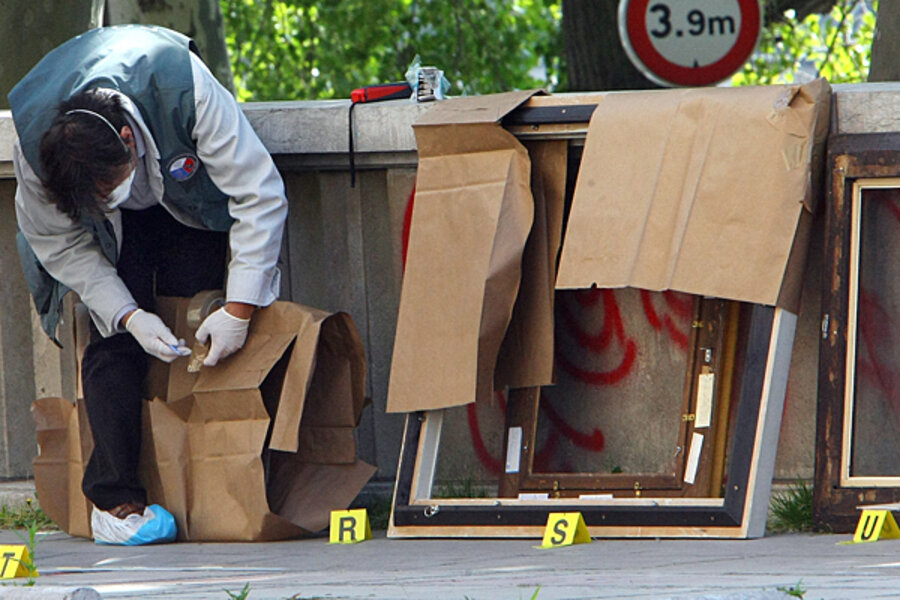Paris art heist: The alarm that didn't sound, the dog that didn't bark
Loading...
| Paris
A day after the stunning $123 million heist of art that Paris authorities now say was not insured, fresh revelations are beginning to echo loudly in efforts to reconstruct how five modernist masterpieces could have been stolen in early dawn hours Thursday.
Apparently, the alarm at the Paris Museum for Modern Art was too quiet for guards to hear.
While Paris city authorities, including Mayor Bertrand Delanoe, said Wednesday that the museum's alarm system was malfunctioning, deputy mayor for culture Christophe Girard elaborated today on the point. He told journalists that the device that shrieks the alarm was essentially not working – a substantial argument for an inside job, since the thief would have had to know the circumstance.
Even more embarrassing, the malfunctioning alarm was reported to security company Spie on March 30 but had yet to be fixed.
IN PICTURES: Famous art heists
Five of the world's most famous representative modern paintings were stolen when the thief sawed off an outside window grill lock, removed both the window and its frame, then took 15 minutes to slice the canvases out of their frames. An internal CCTV camera caught for a few seconds a darkly dressed, bulky figure wearing a ski or skull cap, before he adroitly avoids the camera's radius – suggesting familiarity with the security system.
Whether expensive cameras trained on the paintings were disabled or not turned on remains vague, since Mr. Girard today said the cameras were working but at some point went “opaque." Roof cameras at the museum were set in the wrong direction.
That the thief knew to choose a window and room where the alarm would not make a sound suggested to analysts a thief with “inside” knowledge of the museum or its security. Mr. Girard said "the theft was conducted with such an extreme level of sophistication that it seems it was done by organized crime."
Security lapses well documented
Coincidentally, in 2001, a French video artist made a short documentary detailing various security lapses at the museum, including dozing guards and alarm wires that could be cut, allowing escape through an emergency exit.
Fabrice Bousteau, chief editor of Beaux Arts Magazine, says he was not surprised by the theft, citing the 2001 documentary on security lapses, and added that “fool proof security will never exist.”
The alarm that didn’t go off, which was installed and maintained by the large European security company Spie when the museum was renovated four years ago at a cost of €15 million ($18.9 million), has increasingly become a focus of an investigation called for by Mayor Delanoe. Spie, which provides security for firms like Airbus, said in statements today they are cooperating with French authorities. It remained unclear why the security alarm went unrepaired for nearly two months.
The stolen works include Pablo Picasso's "Le pigeon aux petits-pois" (The Pigeon with the Peas); "La Pastorale" (Pastoral) by Henri Matisse; "La femme a l'eventail" (Woman with a Fan) by Amedeo Modigliani; "L'olivier pres de l'Estaque" (Olive Tree near Estaque) by Georges Braque; and "Nature morte aux chandeliers" (Still Life with Chandeliers) by Fernand Leger.
"Even in a world of human suffering, this is worth a tear," Jonathan Jones writes today in The Guardian.
Earlier this month, Picasso's “Nude, Green Leaves and Bust” was auctioned at Christie’s for $106.5 million, making it the most expensive piece of art ever sold.
Where might the paintings end up?
But since the stolen pieces are far too famous to be sold on the open market, experts have been noodling three main ideas about a rationale of profitable disposal.
The thief may sell the paintings to a lone art egoist wishing to possess the precious historical pieces as his or her own. This theory gained prominence after the $500 million theft from Boston's Isabella Gardner museum in 1990, never solved, when art security firms described anonymous buyers, often in Asia, whose collections existed unseen and unknown.
There’s an “art hostage” theory, in which the stolen works are photographed and held for ransom on the threat of damage or loss. Another is the “parallel market” concept in which fantastically valuable art becomes part of collateral or barter in trades involving drugs or arms or other contraband – a thieves' market, so to speak.
Paris's Museum of Modern Art is part of the Palace of Tokyo, itself part of a set of tall modernist-era structures along the Seine at Trocadero – built for the 1937 universal exhibition that featured both Picassos’ famous Guernica painting of the carnage of Nazi civilian bombing, and also a German-Nazi exhibit with a huge swastika that was placed directly across from an image of a Soviet worker.
The French online Rue 89 reported today a "source close to the mayor's office" said the works were not insured. "To put things simply," this source said, "it will be from our own [the city’s] pocket."
IN PICTURES: Famous art heists
Related:





